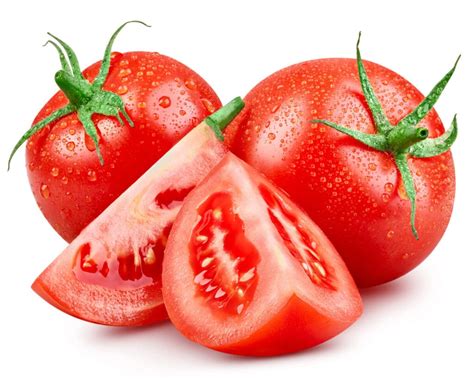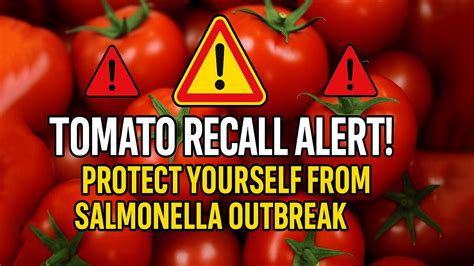
Tomato Recall: Salmonella Scare Spreads Across 8 States!
A salmonella outbreak linked to Roma tomatoes has prompted a recall across eight states, triggering concerns about food safety and public health. The U.S. Food and Drug Administration (FDA) is currently investigating the outbreak, urging consumers to exercise caution and discard potentially contaminated produce.
The implicated Roma tomatoes were distributed to retail stores, restaurants, and food service operators in Florida, North Carolina, South Carolina, Georgia, Alabama, Tennessee, Pennsylvania, and Virginia. The FDA, working in collaboration with the Centers for Disease Control and Prevention (CDC) and state partners, is actively tracing the source of the contamination.
Scope of the Recall
The recall involves specific shipments of Roma tomatoes, and authorities are working to pinpoint the exact source and extent of the distribution. The affected tomatoes were sold as loose, individual produce items, making identification challenging for consumers.
“Consumers who have recently purchased Roma tomatoes in the listed states should be particularly vigilant,” advises an FDA spokesperson. “If you are unsure about the origin of your tomatoes, it is best to err on the side of caution and discard them.”
Symptoms of Salmonella Infection
Salmonella is a bacterium that can cause a common foodborne illness. Symptoms of salmonella infection, known as salmonellosis, typically develop 12 to 72 hours after infection and can include diarrhea, fever, abdominal cramps, nausea, vomiting, and headache.
According to the CDC, most people recover from salmonellosis within four to seven days without medical treatment. However, in some cases, the infection can be severe and require hospitalization, particularly for infants, young children, the elderly, and individuals with weakened immune systems. In rare instances, salmonella infection can spread from the intestines to the bloodstream and other parts of the body, leading to serious complications and even death.
Investigation and Response
The FDA is conducting traceback investigations to determine the origin of the contaminated tomatoes. This involves examining the supply chain, from farms to processing facilities to distribution centers, to identify potential points of contamination. The agency is also collecting samples for laboratory testing to confirm the presence of salmonella and identify the specific strain involved in the outbreak.
“Our priority is to protect public health and prevent further illnesses,” stated a senior FDA official. “We are working diligently with our partners to identify the source of the contamination and take appropriate measures to mitigate the risk.”
The FDA advises consumers who have experienced symptoms of salmonellosis after consuming Roma tomatoes to seek medical attention immediately. It is also important to report the illness to your local health department, as this information can help public health officials track the outbreak and identify additional cases.
Preventive Measures
To prevent salmonella infection, the FDA recommends following these food safety guidelines:
- Wash your hands thoroughly with soap and water for at least 20 seconds before and after handling food.
- Wash fruits and vegetables thoroughly under running water, even if you plan to peel them.
- Use a clean cutting board and utensils when preparing food.
- Keep raw meats, poultry, and seafood separate from fruits, vegetables, and cooked foods.
- Cook foods to safe internal temperatures.
- Refrigerate perishable foods promptly.
- Avoid consuming raw or undercooked foods of animal origin.
Previous Outbreaks and Recalls
Foodborne illnesses caused by salmonella are a recurring public health concern. In recent years, there have been several outbreaks linked to various food products, including fruits, vegetables, eggs, and poultry. These outbreaks highlight the importance of robust food safety practices and effective surveillance systems to detect and respond to potential contamination.
The FDA has implemented several measures to improve food safety, including the Food Safety Modernization Act (FSMA), which aims to prevent foodborne illnesses before they occur. FSMA requires food producers to implement preventive controls, such as hazard analysis and critical control points (HACCP) plans, to identify and address potential food safety risks.
Consumer Advice
Consumers in the affected states are advised to take the following precautions:
- Check your refrigerators and pantries for Roma tomatoes.
- If you are unsure about the origin of your tomatoes, discard them immediately.
- Wash your hands, countertops, and utensils thoroughly after handling tomatoes.
- If you have experienced symptoms of salmonellosis, seek medical attention.
- Report any illnesses to your local health department.
The FDA is continuing to investigate the outbreak and will provide updates as more information becomes available. Consumers can stay informed by visiting the FDA website and following the agency’s social media channels.
Economic Impact
Food recalls can have significant economic impacts on the food industry. Recalling contaminated products can result in substantial financial losses for producers, distributors, and retailers. In addition, recalls can damage consumer confidence and brand reputation, leading to long-term sales declines.
The tomato industry is a major agricultural sector in the United States, with significant production in Florida, California, and other states. A widespread salmonella outbreak can disrupt the supply chain and cause price fluctuations, affecting both consumers and producers.
The economic impact of the current recall will depend on the extent of the contamination and the duration of the investigation. However, it is likely to result in significant losses for the tomato industry and increased scrutiny of food safety practices.
Global Implications
Food safety is a global concern, and outbreaks of foodborne illnesses can have international implications. The global food supply chain is increasingly interconnected, meaning that contamination in one country can quickly spread to others.
International organizations, such as the World Health Organization (WHO) and the Food and Agriculture Organization (FAO), play a critical role in coordinating efforts to prevent and control foodborne illnesses. These organizations provide guidance and technical assistance to countries to strengthen their food safety systems.
The current tomato recall highlights the importance of international collaboration to ensure food safety and prevent the spread of foodborne illnesses across borders.
Long-Term Solutions
Preventing future outbreaks of foodborne illnesses requires a multi-faceted approach that includes:
- Strengthening food safety regulations and enforcement.
- Improving food safety practices at farms, processing facilities, and retail establishments.
- Enhancing surveillance systems to detect and respond to potential contamination.
- Educating consumers about food safety practices.
- Investing in research to develop new technologies for detecting and preventing foodborne illnesses.
By implementing these measures, we can reduce the risk of foodborne illnesses and protect public health.
Political and Regulatory Response
The ongoing salmonella outbreak is likely to prompt further scrutiny from lawmakers and regulatory agencies. Food safety has become an increasingly important political issue in recent years, and lawmakers are under pressure to take action to prevent future outbreaks.
The FDA is likely to face questions about its oversight of the tomato industry and its response to the outbreak. Lawmakers may also consider strengthening food safety regulations and increasing funding for food safety programs.
The political and regulatory response to the outbreak will likely have a significant impact on the food industry and the future of food safety in the United States.
The Role of Technology
Technology is playing an increasingly important role in food safety. New technologies, such as DNA sequencing and blockchain, are helping to improve the detection and traceability of foodborne illnesses.
DNA sequencing can be used to identify the specific strain of salmonella involved in an outbreak, allowing public health officials to trace the contamination to its source. Blockchain technology can be used to create a secure and transparent record of the food supply chain, making it easier to track products from farm to table.
These technologies have the potential to revolutionize food safety and prevent future outbreaks of foodborne illnesses.
The Consumer Perspective
Consumers are increasingly concerned about food safety and are demanding more transparency from the food industry. Many consumers are now paying closer attention to food labels and are seeking out products that are certified organic or non-GMO.
Consumers are also using technology to learn more about the food they eat. Online resources, such as the FDA website and the CDC website, provide information about food safety risks and preventive measures.
Consumers have a critical role to play in preventing foodborne illnesses. By following food safety guidelines and staying informed about food safety risks, consumers can protect themselves and their families.
Impact on Restaurants and Food Service
Restaurants and food service establishments are also significantly impacted by the tomato recall. They must ensure that they are not serving contaminated tomatoes to their customers, which requires them to verify the source of their tomatoes and discard any potentially affected products.
The recall can disrupt supply chains and increase costs for restaurants, as they may need to find alternative sources for tomatoes. It can also damage their reputation if customers become ill after consuming contaminated food at their establishment.
Restaurants are advised to follow the FDA’s recommendations and take proactive measures to prevent foodborne illnesses. This includes training employees on food safety practices, implementing food safety management systems, and regularly inspecting their facilities.
The Future of Food Safety
Food safety will continue to be a major challenge in the years ahead. The global food supply chain is becoming increasingly complex, and new food safety risks are emerging all the time.
To meet these challenges, we need to invest in research, technology, and education. We also need to strengthen food safety regulations and enforcement.
By working together, we can create a safer and more secure food supply for everyone.
Detailed Analysis of Salmonella
Salmonella is a genus of rod-shaped (bacillus) Gram-negative bacteria of the family Enterobacteriaceae. The two species of Salmonella are Salmonella enterica and Salmonella bongori. Salmonella enterica is further divided into six subspecies, each with numerous serovars. These serovars are often referred to as serotypes.
Salmonellosis, the infection caused by Salmonella bacteria, is one of the most common bacterial foodborne diseases worldwide. The bacteria are usually transmitted to humans through contaminated food of animal origin, but other foods, including vegetables and fruits, can also be contaminated.
Factors Contributing to Contamination
Several factors can contribute to the contamination of tomatoes with Salmonella:
- Irrigation Water: If irrigation water is contaminated with animal feces, the bacteria can transfer to the tomatoes. This is especially concerning if the water source is near livestock or if agricultural runoff is not properly managed.
- Soil Contamination: Soil can be contaminated with Salmonella from various sources, including manure, compost, and wildlife. Tomatoes grown in contaminated soil can become infected.
- Harvesting and Handling: During harvesting and handling, tomatoes can come into contact with contaminated surfaces, equipment, or workers’ hands. Proper hygiene and sanitation practices are crucial to prevent contamination.
- Processing and Packaging: Contamination can also occur during processing and packaging. If equipment is not properly cleaned and sanitized, Salmonella can spread to the tomatoes.
- Cross-Contamination: Cross-contamination can occur in retail stores and restaurants if tomatoes come into contact with contaminated surfaces or other foods.
FDA’s Role in Prevention
The FDA plays a critical role in preventing Salmonella contamination in tomatoes and other food products. The agency has several programs and initiatives in place to ensure food safety, including:
- Food Safety Modernization Act (FSMA): FSMA is the most sweeping reform of food safety laws in more than 70 years. It aims to prevent foodborne illnesses by requiring food producers to implement preventive controls and by giving the FDA more authority to inspect and regulate food production facilities.
- Produce Safety Rule: This rule, mandated by FSMA, establishes science-based minimum standards for the safe growing, harvesting, packing, and holding of fruits and vegetables for human consumption. It addresses potential sources of contamination and requires farmers to implement measures to minimize risks.
- Traceability: The FDA is working to improve traceability in the food supply chain, which will make it easier to track contaminated products to their source and remove them from the market quickly.
- Outbreak Response: The FDA works closely with the CDC and state partners to investigate foodborne illness outbreaks and take appropriate action to protect public health.
The Importance of Traceability
Traceability is essential for effectively responding to foodborne illness outbreaks. When an outbreak occurs, public health officials need to quickly identify the source of the contamination and remove the affected products from the market. Traceability systems allow them to trace the product back through the supply chain, from the point of sale to the farm where it was grown.
Effective traceability systems require accurate and detailed records at every stage of the supply chain, including:
- Farm identification
- Harvesting dates
- Packing and processing information
- Distribution records
- Retail sales data
Consumer Protection and Education
Consumer protection and education are also important components of food safety. Consumers need to be informed about the risks of foodborne illnesses and how to prevent them. The FDA provides a variety of resources for consumers, including:
- Food safety tips
- Recall information
- Information about foodborne illnesses
- Guidance on safe food handling practices
Frequently Asked Questions (FAQ)
-
What states are affected by the tomato recall?
- The tomato recall affects Florida, North Carolina, South Carolina, Georgia, Alabama, Tennessee, Pennsylvania, and Virginia.
-
What are the symptoms of a salmonella infection?
- Symptoms typically include diarrhea, fever, abdominal cramps, nausea, vomiting, and headache, usually appearing 12 to 72 hours after infection.
-
What should I do if I think I have salmonella from the tomatoes?
- Seek medical attention immediately and report the illness to your local health department.
-
How can I identify the recalled tomatoes?
- The affected tomatoes were sold as loose, individual Roma tomatoes. If you are unsure about the origin, discard them.
-
What is the FDA doing to address this outbreak?
- The FDA is conducting traceback investigations to determine the source of the contamination and is working with the CDC and state partners to mitigate the risk. They also advise consumers to follow food safety guidelines.
Detailed Breakdown of the Impact
The tomato recall has several layers of impact, affecting various stakeholders within the food industry and beyond.
1. Agricultural Sector:
- Tomato Growers: Farmers face immediate financial losses due to the recall of their produce. Even those not directly implicated may experience a decrease in demand and lower prices as consumers become wary of purchasing tomatoes. The cost of implementing enhanced safety measures and traceability systems adds to their burden. The ability to market their products depends on quickly restoring consumer trust.
- Agricultural Workers: The recall can lead to temporary or permanent job losses for farmworkers involved in harvesting, packing, and processing tomatoes. This affects their livelihoods and the economies of agricultural communities.
- Input Suppliers: Companies that supply seeds, fertilizers, pesticides, and other inputs to tomato growers may also experience a decrease in demand.
2. Food Processing and Distribution:
- Packing and Processing Plants: Facilities that pack and process tomatoes face the cost of recalling and disposing of contaminated products. They must also implement stricter cleaning and sanitation protocols to prevent future contamination.
- Distributors: Food distributors are responsible for transporting tomatoes from farms to retail stores and restaurants. The recall disrupts their supply chains and can lead to financial losses. They need to quickly identify and remove contaminated products from their inventory.
- Transportation Companies: Trucking companies and other transportation providers may experience a decrease in business as tomato shipments are reduced.
3. Retail and Food Service:
- Grocery Stores: Supermarkets must remove recalled tomatoes from their shelves and notify customers about the recall. They may experience a decrease in sales of tomatoes and other produce items as consumers become more cautious. The cost of replacing contaminated products and managing customer inquiries adds to their expenses.
- Restaurants: Restaurants that use tomatoes in their dishes face the challenge of finding alternative sources of supply. They must also ensure that their kitchens are thoroughly cleaned and sanitized to prevent cross-contamination. The recall can damage their reputation if customers become ill after consuming contaminated food. Fast-food chains and establishments that rely heavily on tomatoes in their menu could experience significant financial setbacks.
- Catering Companies: Catering services must be especially vigilant in sourcing safe tomatoes and informing clients about the recall. They risk significant damage to their reputation if contaminated tomatoes are served at events.
4. Consumers:
- Health Risks: Consumers who eat contaminated tomatoes face the risk of developing salmonellosis, which can cause unpleasant symptoms and, in some cases, serious complications. Vulnerable populations, such as young children, the elderly, and people with weakened immune systems, are at higher risk.
- Economic Impact: Consumers may experience higher prices for tomatoes and other produce items as the supply chain is disrupted. They may also incur medical expenses if they become ill from eating contaminated tomatoes.
- Loss of Trust: Food recalls can erode consumer trust in the food supply and make people more hesitant to purchase certain products.
5. Regulatory and Governmental Bodies:
- Food and Drug Administration (FDA): The FDA is responsible for investigating the outbreak, identifying the source of contamination, and implementing measures to prevent future outbreaks. The agency’s reputation and effectiveness are under scrutiny during a recall.
- Centers for Disease Control and Prevention (CDC): The CDC tracks cases of salmonellosis and provides guidance to the public on how to prevent infection. The CDC’s data is crucial for understanding the scope and severity of the outbreak.
- State and Local Health Departments: State and local health departments work to investigate outbreaks, trace the source of contamination, and notify the public about recalls. They play a crucial role in protecting public health.
6. Broader Economic Implications:
- Tourism and Hospitality: In regions where tourism and hospitality are major industries, food recalls can have a significant impact. Visitors may be less likely to eat out or purchase local produce if they are concerned about food safety.
- International Trade: Food recalls can disrupt international trade and damage the reputation of U.S. agricultural products. Countries that import tomatoes from the United States may impose stricter testing requirements or ban imports altogether.
- Legal and Insurance: Lawsuits may be filed against companies involved in the production, distribution, and sale of contaminated tomatoes. Insurance companies may face significant claims related to the outbreak.
The Role of Technology in Mitigation and Prevention
Technology offers several promising solutions for mitigating the impact of foodborne illness outbreaks and preventing future occurrences.
- Advanced Traceability Systems: Blockchain technology can create a secure and transparent record of the food supply chain, making it easier to trace products from farm to table. This allows public health officials to quickly identify the source of contamination and remove affected products from the market. Real-time tracking systems using IoT (Internet of Things) sensors can monitor temperature, humidity, and other environmental factors that can affect food safety.
- Rapid Detection Methods: New technologies, such as DNA sequencing and biosensors, can rapidly detect Salmonella and other pathogens in food samples. These methods can be used to test tomatoes at various stages of the supply chain, from the farm to the retail store.
- Data Analytics: Big data analytics can be used to identify patterns and trends that can help prevent foodborne illness outbreaks. By analyzing data from various sources, such as food safety inspections, consumer complaints, and environmental monitoring, public health officials can identify potential risks and take proactive measures to address them.
- Enhanced Sanitation Technologies: Advanced sanitation technologies, such as UV-C light and ozone treatment, can be used to disinfect equipment and surfaces in food processing facilities. These technologies can kill Salmonella and other pathogens without the use of harsh chemicals.
- Consumer Education Apps: Mobile apps can provide consumers with information about food safety recalls, safe food handling practices, and potential risks associated with certain foods. These apps can also allow consumers to report foodborne illnesses to public health officials.
Conclusion
The tomato recall underscores the critical importance of food safety and the complex challenges involved in preventing foodborne illness outbreaks. The outbreak has a wide-ranging impact on various sectors, from agriculture to retail to consumer health. While the immediate focus is on identifying the source of the contamination and mitigating the spread of the outbreak, it is also essential to implement long-term solutions to strengthen food safety regulations, improve food safety practices, and enhance surveillance systems. Technology will play a key role in these efforts, providing tools for traceability, rapid detection, data analytics, and enhanced sanitation. By working together, government agencies, industry stakeholders, and consumers can create a safer and more secure food supply for everyone.









